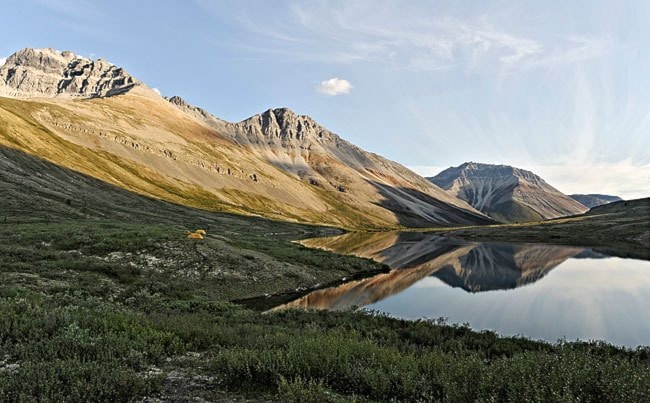The Supreme Court of Canada has agreed to hear the case involving the Peel River watershed.
The country’s top court said Thursday it will have the final say over how far back in the planning process the Yukon government gets to go when deciding what to do with the land.
The Supreme Court of Canada only hears about 10 per cent of the cases that apply. Judges don’t have to give reasons for their decision to hear a case, just a simple yes or no.
Based on how long it usually takes, it’s unlikely the Peel case will be heard by the court until next year.
Three Yukon First Nations - the Tr’ondek Hwech’in First Nation, the First Nation of Nacho Nyak Dun and the Vuntut Gwitchin - and two conservation groups are suing the government over its plan for the 68,000 square kilometres of mostly undisturbed Yukon wilderness.
In 2011, after about seven years of work, a planning commission recommended that only 20 per cent of the land be open for resource industries right away.
In January 2014 the Yukon government released its own plan for the Peel, which opened up 71 per cent of the area to some type of new mineral staking.
Both the Yukon Supreme Court and the Yukon Court of Appeal ruled the Yukon government failed to honour the letter and spirit of its treaty obligations when it released its plan that was so dramatically different than anything that had been discussed before.
“The Supreme Court’s decision confirms what we’ve maintained all along: there are significant legal questions raised by the Yukon government’s conduct during the Peel planning process that deserve the Supreme Court’s - and Canada’s - attention,” Chief Roberta Joseph of the Tr’ondek Hwech’in said in a statement.
“We are thankful for this opportunity and look forward to defending the integrity of our final agreements.”
The case now boils down to how to fix the mistake.
When Justice Ron Veale of the Yukon Supreme Court ruled in 2014, he said the Yukon government couldn’t make changes to the recommended plan that it hadn’t already talked about in detail earlier.
That essentially meant that whatever it came up with would end up looking a lot like the recommended plan.
The court of appeal took things back a step further, saying the government could make more changes as long as it consulted about them first.
The First Nations and environmental groups think it’s wrong for the government to be given this “do-over” after not meeting its obligations.
“We signed our final agreements with Canada and the government of Yukon in 1993, and we came to the table again in good faith for the Peel watershed consultations,” said Chief Simon Mervyn of the First Nation of Na-Cho Nyak Dun.
“We are pleased that Canada’s highest court recognizes the legally binding nature of these agreements and the national significance of this case.”
In order to hear a case, the Supreme Court of Canada has to believe it has national importance.
Jeff Langlois, a lawyer who has taken part in the case for the Gwich’in Tribal Council, said the Peel situation has that kind of significance.
Courts have consistently said First Nations need to participate in good faith in the consultation process if they want their concerns heard, he said.
“The shoe’s really on the other foot now, where it’s the Yukon who failed to bring forward its concerns about the recommended plan.
“Yet the court of appeal granted a remedy which basically allowed the Yukon to go back and basically have a do-over. I think there’s an important point here about equity between the First Nations and the Crown here.”
The Yukon government, meanwhile, is maintaining its position that public government should have final say over public land.
“While continuing to have this matter in the courts is not the Yukon government’s preferred approach, we are hopeful that the Supreme Court of Canada can provide clarity and certainty to questions about how Yukon’s regional land use planning process should work and can make it clear that public government has the final say over public land,” the Yukon government said in a statement.
The prohibition on mineral staking and oil-and-gas development in the Peel watershed remains in place until Jan. 1, 2018.
Opposition politicians took the top court’s decision as an the opportunity to take a shot at the Yukon Party with their eyes clearly on this year’s election.
“The fate of the Peel - one of North America’s last pristine natural ecosystems - will be up to the Yukon people who will choose Yukon’s next government,” said NDP Opposition Leader Liz Hanson.
“Under a Yukon NDP government, that means a Peel decision that reflects the final recommended plan, respects the balance struck by the land use planning process and upholds the spirit and intent of the Yukon’s final agreements with First Nations governments.”
The Liberals also say they will implement the recommended plan if elected.
“Land use planning brings certainty for economic development while protecting our shared environment for future generations. When these decisions are left to the Supreme Court of Canada to decide, we lose our ability and responsibility to negotiate our shared future through a local lens,” said Liberal Leader Sandy Silver.
“The Yukon Party government has fought the will of the people at every turn. Today’s decision is a reminder of their inability to consult or negotiate with First Nation governments.”
Contact Ashley Joannou at
ashleyj@yukon-news.com
